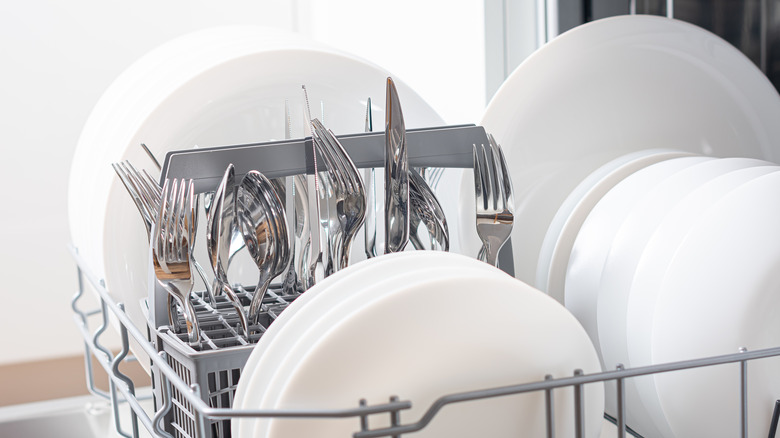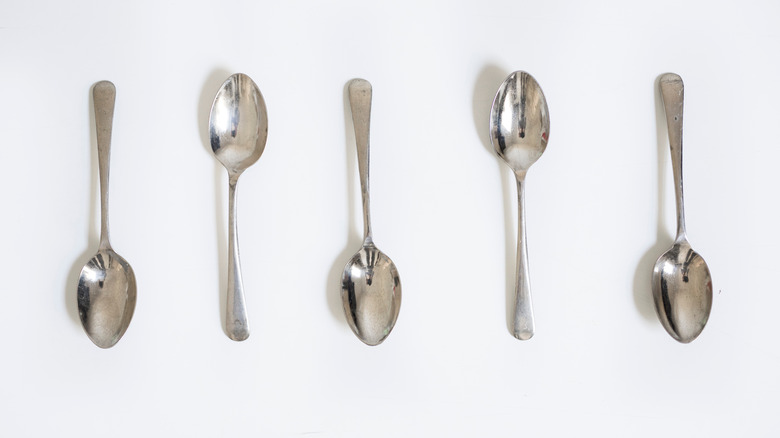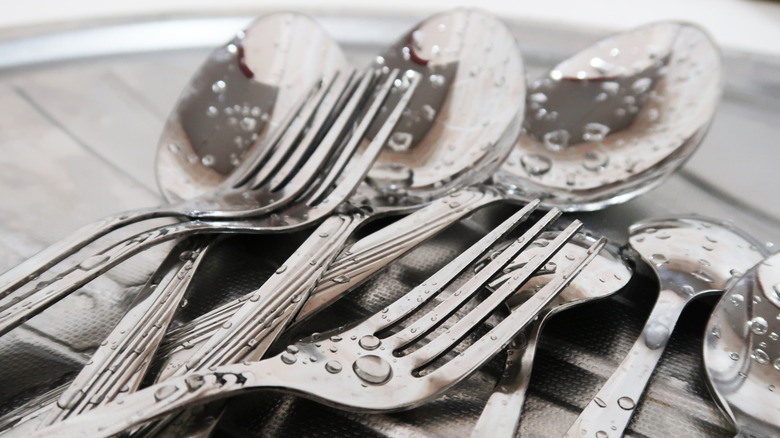The Right Way To Load Silverware Into Your Dishwasher
For such a simple chore, washing flatware can seem like a task riddled with more questions than answers. To soak or not to soak? Which dish soap should you use? Can real silverware go in the dishwasher? Mary Hunt, founder of Everyday Cheapskate, explains that, yes, you can put real, solid silver through a washing cycle — as long as you separate the pieces from other metals to avoid electrolytic reactions. Real silver should also be well-rinsed before going in the dishwasher to prevent rusting. Fair enough, you might think, but should you place everything face up or down, and why should it matter?
There are two important factors to consider when loading silverware: cleanliness and safety. Pointing these utensils down may seem more hygienic because you won't need to touch the mouth end to put them away, but doing so could create other problems during washing. This is especially likely if the silverware is too tightly bunched together. At the same time, pointing everything up can be impractical and downright dangerous with some sharp tools. The solution to these woes is simple: mix it up.
Alternate your silverware
Even appliance experts may disagree about which way to load silverware, according to Digital Trends, but most say alternating is the best solution. While doing so all in one direction may seem easier, it can cause your cutlery to spoon together (no pun intended). Spooning prevents the water from reaching all angles of your flatware, leading to stuck-on spots and crumbs. If you're worried about jabbing yourself on a fork while loading or unloading the dishwasher, place all of your forks down and spoons up. Just be sure to space them out evenly.
With that being said, butter knives and other sharp tools should always be pointed down in your dishwasher. Attempting to alternate your knives could result in accidentally slicing your hands while you're loading or unloading. Don't lay sharp items across the top rack, either. High-pressure water can cause items to shift during washing, and these could slip down and injure your hands or feet while you're putting these items away. Many experts warn against placing cooking knives in your dishwasher at all. After all, the high heat, alkaline water, and intense pressure can cause your fancy knives to rust, dull, and even break at the handle (via Kitchn), so stick to hand-washing if you want to prolong the lives of your knives.
Keep up with regular maintenance
For the best results with your silverware, you'll need to consider other factors in your dishwashing routine, too. Pre-washing is crucial to ensure they don't become rusty, crusty, or tarnished in the dishwasher, but don't let them soak too long. Already too late? The professional cleaners at Handy recommend several methods for removing tarnish spots from silverware, including a simple baking soda scrub. Additionally, it's important to keep up with regular maintenance and polishing to avoid ruining your cutlery. You should also avoid placing large plates or pans in front of your flatware compartments, as these could block water jets during the wash cycle.
Although convenient, dishwashers are not maintenance-free appliances. As Kitchn advises, homeowners should regularly clean their machines once per month, removing debris from the food trap and running a cycle with vinegar to sterilize. Thoroughly cleaning it will ensure your dishes continue to come out shiny and sanitary. When in doubt about anything, it's best to refer to your dishwasher's instruction manual. Most include specific steps for cleaning and loading, as well as tips to help you get the best clean possible.


